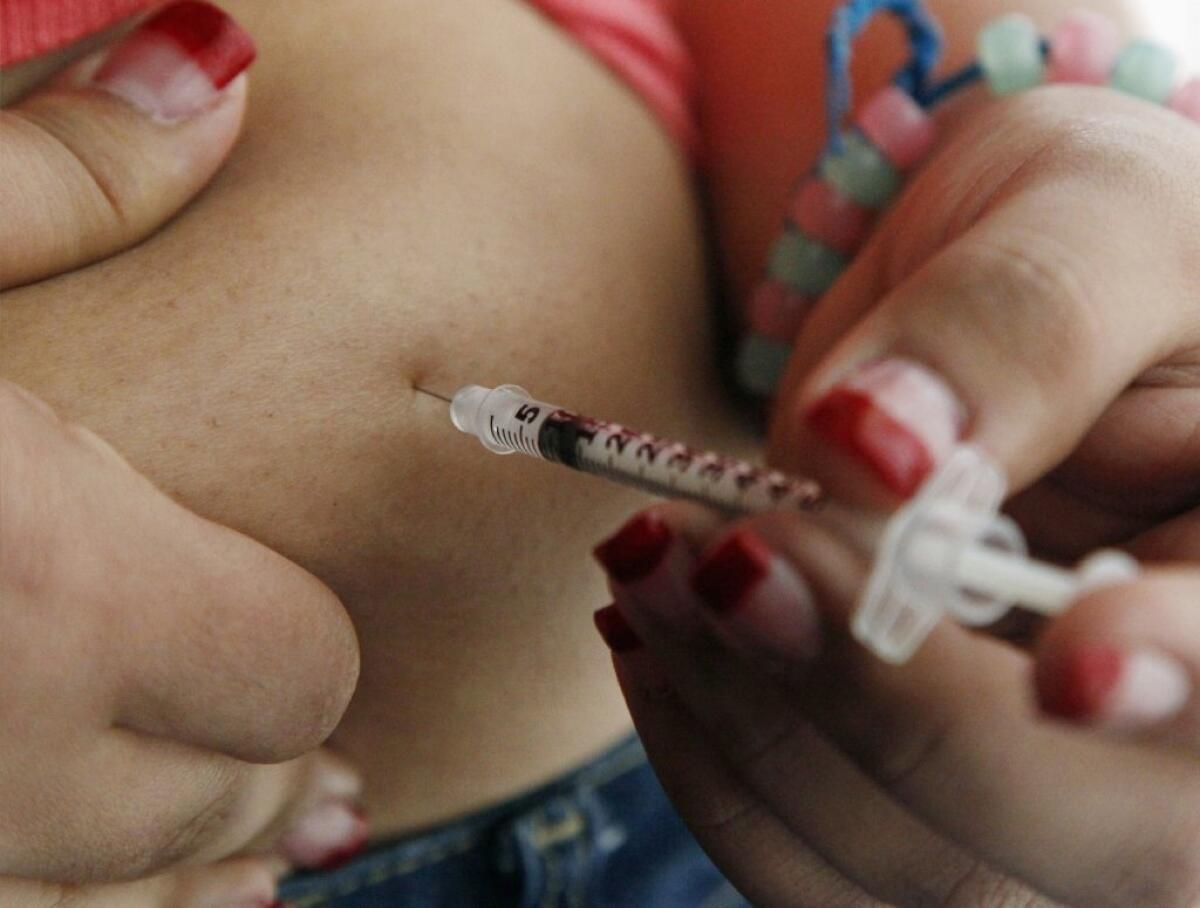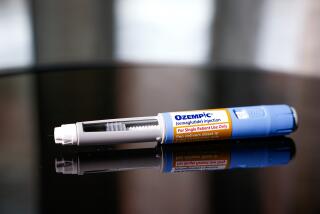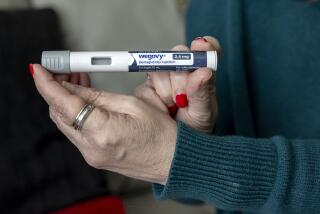Can treating the brain help in the fight against diabetes?

- Share via
In research that may point the way to new treatments for Type 2 diabetes, obese and diabetic mice who got a single shot of a growth-promoting peptide directly into their brains experienced lasting remission from the metabolic disorder without any sustained changes to their diet or their weight.
A week after researchers injected a low dose of synthesized mouse Fibroblast Growth Factor 1 — FGF1 — directly into the ventricles of diabetic mouse brains, the mice’s erratic blood glucose levels stabilized at normal levels. Then they stayed normal for 17 weeks — effectively curing the mice of their diabetes.
See the most-read stories in Science this hour >>
It was a level of remission until now seen only in the wake of bariatric surgery, the authors reported Monday in the journal Nature Medicine. The study was led by endocrinologist Michael W. Schwartz, gastroenterologist Jarrad M. Scarlett and molecular physiologist Jennifer M. Rojas. Schwartz directs the University of Washington’s Diabetes and Obesity Center of Excellence and Scarlett and Rojas conduct research there.
The success of a direct-to-the-brain treatment for diabetes in mice is unlikely to prompt such radical treatments for humans — not anytime soon, at least. But it does highlight a little-appreciated surmise about Type 2 diabetes: that it may be, to some extent at least, a brain disease, and that treatments that go to the source of the metabolic dysfunction may lead to “cures” that have not been achieved by treating its downstream effects in the pancreas, blood, liver, muscles and fat.
“That’s a novel perspective,” Schwartz said. The ways in which the brain influences diabetes are not understood, he added. But “there’s enough data to take a good look at” the relationship.
The introduction of FGF1 into the brain’s fluid-filled caverns appeared to unleash a sequence of changes in the mice. Production of a powerful neuroprotective protein surged in the brain. That, in turn, fostered the robust growth of brain connections in the hypothalamus — the source of many hormones that play a role on appetite and metabolism. Outside the brain, the skeletal muscles and livers of the diabetic mice quickly improved their uptake of post-meal glucose. As glucose clearance improved, the high blood-sugar levels that are a hallmark of Type 2 diabetes quickly normalized.
Researchers saw no evidence that the treated mice were plagued by hypoglycemia — a problem of over-correction that many on Type 2 diabetes treatments experience. Nor, they concluded, were the metabolic improvements the result of weight loss: while treated mice briefly dialed back their intake and lost some weight, their appetites and their weight quickly returned.
But their Type 2 diabetes was gone.
To ensure that the effect they were seeing was real, the authors of the new research repeated the experiment on rats, as well as on mice that were bred to develop Type 2 diabetes by a different means than did the first set of mice. In both cases, a single infusion of FGF1 had the same anti-diabetic effect.
“Except for certain bariatric surgical procedures, we are unaware of any intervention capable of inducing sustained remission of Type 2 diabetes in humans or rodents,” the authors wrote. The administration of FGF1 directly into the brain, the authors wrote, “unmasks the brain’s inherent capacity to induce sustained diabetes remission.” And all, they added, “without the need for surgical revision of the gastrointestinal tract.”
While pumping growth factor directly into human brains may seem unwieldy, diabetes treatment that focuses on the brain is not out of reach, the authors wrote. Working with mice and rats, scientists have demonstrated that the intranasal delivery of FGF1 to the brain is feasible.
“We are entering an era where, really, when it comes to treating diabetes using insulin or insulin-related treatments — which they all are — we’ve gotten as far as we’re going to get,” Schwartz said. Increasingly, drug developers “understand there probably are not going to be breakthroughs by hammering away at the same drug targets,” he added.
“So if there’s going to be a paradigm shift in finding treatments that might complement or make other drugs more effective, then targeting the brain might be the way to do this,” he said.
Close to 30 million Americans — more than 9% of the U.S. adult population — suffer from Type 2 diabetes, and new diagnoses are surging as obesity soars and the U.S. population ages.
A wide range of medications are available, and under development, but remission most often requires substantial weight loss. In recent years, bariatric surgery has been recognized as highly effective in allowing diabetic patients to reduce or discontinue medication, but its high cost has limited access to such treatment.
Follow me on Twitter @LATMelissaHealy and “like” Los Angeles Times Science & Health on Facebook.
MORE IN SCIENCE
Meet some amazing animals and plants that are new to science
Found: First-ever evidence of comets beyond the solar system orbiting a sun-like star
Americans could prevent roughly half of all cancer deaths by doing these four things
UPDATES:
6:32 p.m. The story was updated with new information from Dr. Michael Schwartz.
The story was originally posted at 4:01 p.m.







